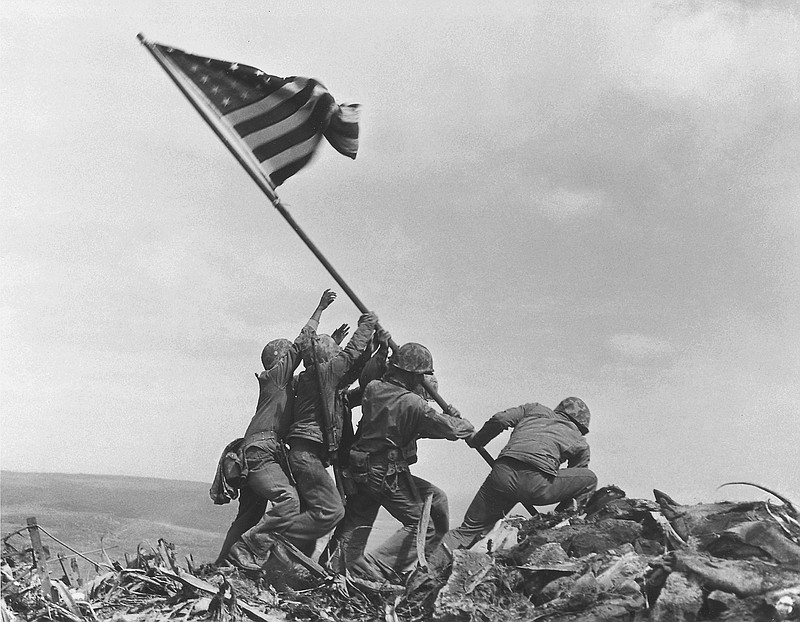Seventy-five years ago, on Feb. 19, 1945, U.S. Marines began amphibious landings on the tiny volcanic island of Iwo Jima in a battle code-named Operation Detachment. The island's strategic value resided in two airfields at its midsection. Capture of the island resulted in one of the bloodiest battles for American forces during World War II.
U.S. intelligence significantly underestimated the Japanese defensive force and predicted victory within a week. Ten days of planned pre-invasion, heavy bombardment from sea and air were reduced to three days.
For months, 18,000 U.S. and Japanese troops had constructed miles of interconnected tunnels that linked heavily fortified pillboxes and gun positions. Rather than attack the invaders at the shoreline, the Japanese held their fire until U.S. forces had come ashore. Defenders could attack with artillery, mortars and heavy machine guns and quickly withdraw before sustaining damage from U.S. bombardment. Defensive weapons could be moved from site to site.
About 30,000 U.S. and Marines of an eventual force of 70,000 landed on the first day of the attack on beaches along the island's southeast coast. At the perimeter of the beaches, they encountered an unexpected, steep wall of soft volcanic ash, which slowed their planned advance for days and limited the use of armored vehicles. Because of links among fortifications, defenders could emerge behind U.S. lines, attack and disappear.
On Feb. 21, a kamikaze aerial attack led to the sinking of the escort carrier U.S.S. Bismarck Sea, which was providing close air support for the invasion, with the loss of 316 crew. Legendary carrier U.S.S Saratoga suffered severe damage and heavy casualties in the same attack and was forced to withdraw to Hawaii for repairs.
Marines secured Mount Suribachi, which rose 550 feet over the southern tip of the island, on Feb. 23. An earlier flag-raising was replaced by the iconic raising of the flag by six Marines, three of whom would be killed in subsequent fighting. The three survivors were transferred stateside after the battle to participate in nationwide drives to sell war bonds. The photograph of the second flag-raising was widely published in U.S. newspapers two days later and became the inspiration for the Marine Corps War Memorial in Washington, D.C. But the battle continued.
Marines captured the two airfields on Feb. 24 and 27.
"Yard by bloody yard" was the way a survivor of the battle described the grueling fight to secure the island. Although the Japanese commander had prohibited kamikaze attacks, a disobedient captain led one on the night of March 8, which resulted in hand-to-hand combat before the attackers were annihilated. This opened a vital gap in the Japanese line.
The final action occurred on March 26 when, under cover of darkness, Japanese troops infiltrated U.S. lines and inflicted heavy casualties before being wiped out.
By battle's end on March 26, 1945, 6,800 Americans had lost their lives; 19,200 had been wounded. More than 18,000 Japanese soldiers were killed or committed suicide. Only 216 were captured. Several hundred hid in the tunnels and conducted periodic attacks until war's end.
Twenty-seven Medals of Honor were awarded to Marines and Navy corpsmen for their extraordinary courage.
Criticism over the Iwo Jima campaign began as soon as the fighting ceased. Advocates for the invasion argued that the island's airfields would be used by fighter aircraft, which would accompany B-29 bombers on their attacks on the Japanese home islands. Because Japanese air defenses had been all but eradicated, only 10 such missions ever occurred.
A second argument for the campaign contended that the airfields would serve as emergency landing sites for U.S. bombers that had been damaged in their missions over Japan. More than 2,000 B-29s that were returning to their bases landed at Iwo Jima.
Could Iwo Jima have been bypassed? There is no clear answer.
The ranks of veterans of World War II are rapidly thinning. If you know of one, now is the time to write or call to express your appreciation for his or her service.
Contact Clif Cleaveland at ccleaveland@timesfreepress.com.

